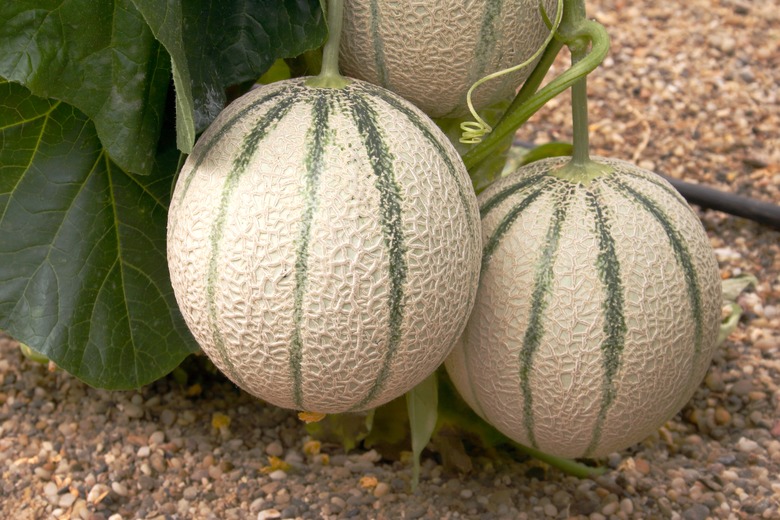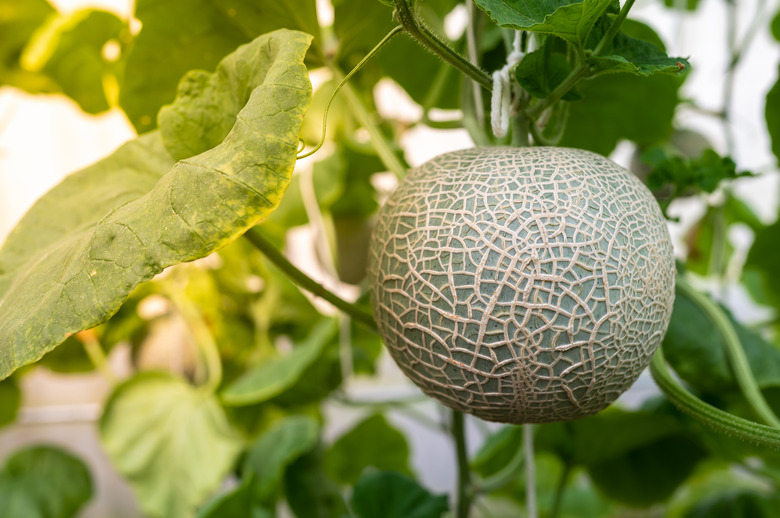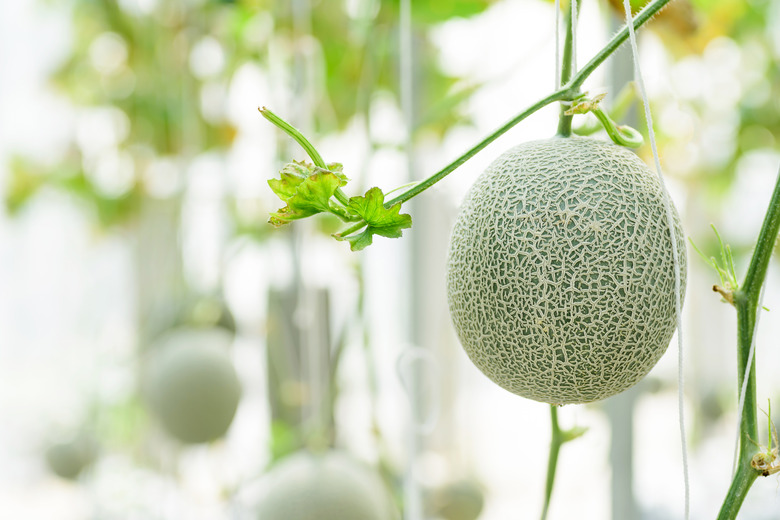How To Grow Cantaloupe
- Best uses for cantaloupe
- How to grow cantaloupe
- Starting cantaloupe from seed
- Transplanting cantaloupe seedlings
- In what zone does cantaloupe grow best?
- When should you plant cantaloupe?
- Soil, sunlight and water recommendations for cantaloupe
- How to propagate cantaloupe
- How to harvest cantaloupe
- Common pests and other problems for cantaloupe
- Common diseases for cantaloupe
Legend has it that cantaloupe (Cucumis melo var. cantalupensis) was gifted to the New World by Christopher Columbus, who stowed seeds for the tasty melons onboard his ship when he made his second voyage in 1494. Growers used these seeds to produce a cultivar known as muskmelon (Cucumis melo var. reticulatus), and to this day, this is the variety commonly cultivated in North America. The North American melon has webbed, somewhat smooth skin and lacks the roughness and longitudinal ribbing of its European forebear, but when it comes to the part that counts — the sweet, orange flesh inside — a muskmelon is basically a cantaloupe.
Cantaloupe is a summer melon, which means it's ready to harvest in mid to late summer in most climate zones provided that you get it in the ground early enough in the season. The fruits grow on a vine that also produces large, thick, green leaves and small, yellow flowers that precede the formation of the melon itself. The vine typically grows along the ground, but it can be trained to climb a fence or a trellis provided that the melons get extra support to prevent them from falling. When gardeners allow the vines to creep on the ground, they usually plant them on hills to ensure good drainage.
The cantaloupe loves warm, sunny weather, which you would expect given its Italian heritage. It doesn't grow as large as a watermelon, and unlike the watermelon, it doesn't have seeds scatted through the flesh. The seeds are concentrated in the middle of the melon and are easy to remove, which together with its rich, sweet taste is why it's such a popular summer treat.
Best Uses for Cantaloupe
Best Uses for Cantaloupe
When left to its own devices, the cantaloupe vine snakes along the ground in whatever direction it can get the most sunlight, and it can grow as long as 30 feet, so it needs a lot of room. To save space, growers often train the vine to grow vertically on a trellis, stake or vertical grow frame, and to prevent the melons from falling, they put them in mesh bags and attach the bags to the support structure. When left on the ground, cantaloupe plants do best when they are planted individually on small hills or collectively in raised rows so that water can drain, but they can also be planted in raised beds or on flat ground in areas without excessive rainfall.
The soil temperature has to remain above 60 degrees Fahrenheit for the entire growing period, so growers often spread black plastic ground cover over the growing area before planting and cut small holes for the seedlings. You can also mulch the plants with leaves, straw or some other organic mulching material, which helps retain moisture in the soil, and cantaloupe plants need a lot of it. When planting in rows, growers often protect the plants with row covers.
You can plant cantaloupe along with a number of companion plants that serve to provide nutrients and generally fill in the spaces provided that none of them blocks the sunlight the cantaloupe needs. Some of the more common companion vegetables include many varieties of peas, chives, garlic, broccoli and okra. A number of herbs and flowers are also beneficial, including mint, sage, dill, marjoram, nasturtiums and marigolds. You should never plant cantaloupe along with watermelon, potatoes or cucumbers.
How to Grow Cantaloupe
How to Grow Cantaloupe
- Common Name: Cantaloupe
- Botanical Name: Cucumis melo var. cantalupensis and
Cucumis melo var. reticulatus
- When to Plant: Wait until after the last frost when the soil temperature has risen to 60 degrees.
- USDA Zones: Grow as an annual in zones 3-11 (depending on cultivar)
- Sun Exposure: Full sun
- Soil Type: Loose, rich, well-draining soil with a pH between 6.0 and 6.5
- When it's in Trouble: Flowers fall off, and fruit fails to develop in extreme heat. Fruit may not develop if there are no bees or other pollinators to transfer pollen from the male flowers to the female ones.
- When it's Thriving: Leaves are large and dark green, and melons are well-formed.
Starting Cantaloupe From Seed
Starting Cantaloupe From Seed
Cantaloupe seeds have a pointed end and a rounded one, and since the roots emerge from the pointed end, it should face down. Make a hole about 1/2 inch deep in rich potting soil (or loose soil amended with organic matter such as compost or well-rotted manure), drop two or three seeds into each hole, tamp the soil back and water gently. The seeds take about a week to 10 days to germinate, and the soil should be kept moist during that time.
It helps to cover the seed beds to retain moisture. If you start seeds indoors, it's important to germinate them in biodegradable containers that you can bury because melon roots are fragile and don't take well to transplanting. When the seedlings emerge, thin them to one per hole or container, and space one seedling every 18 to 24 inches. Seedlings grown indoors need to be hardened off for seven to 10 days before transplanting by taking the containers outside and gradually exposing the plants to sunlight.
Transplanting Cantaloupe Seedlings
Transplanting Cantaloupe Seedlings
Prepare the soil in your raised row or beds by thoroughly mixing in compost, rotted manure or an organic soil amendment to a depth of 12 inches. About three to four weeks after the last frost date, plant seedlings 18 to 24 inches apart, preferably on a mound, and when constructing more than one mound, space the mounds 4 to 6 feet apart. Dig out some soil to create a small rim at the top of each mound to prevent the soil from eroding and exposing the roots of the melon plants when it rains.
In What Zone Does Cantaloupe Grow Best?
In What Zone Does Cantaloupe Grow Best?
In general, most cantaloupe cultivars will grow as annuals in USDA zones 4 to 10. Cantaloupe enthusiasts in zone 3 can successfully grow Hearts of Gold, a cultivar that has been one of the most popular since it was first cultivated in 1900, or Minnesota Midget, a smaller cultivar with a short growing season. The heirloom cultivar Honey Rock can withstand the sultry weather and intense sunshine of zone 11 and is a good choice for growers in that region.
When Should You Plant Cantaloupe?
When Should You Plant Cantaloupe?
Cantaloupe does not tolerate frost at all, so the best time to plant it is when all danger of frost has passed and the soil temperature is consistently above 60 degrees. Depending on the growing season of the cultivar, which can be from 70 to 100 days, it's important in colder regions to get seedlings in the ground as soon as possible, which is generally three to four weeks after the last frost date. In areas that don't get frost, you can sow seeds directly in the ground or plant seedlings as soon as the soil warms to 60 degrees.
Soil, Sunlight and Water Recommendations for Cantaloupe
Soil, Sunlight and Water Recommendations for Cantaloupe
Cantaloupe needs plenty of nutrients, and while you can provide most of these by turning organic matter into the soil before planting, it isn't a bad idea to get a soil test so you can use fertilizers that target deficiencies. Avoid adding excessive nitrogen, though, because that will supercharge foliar growth and produce undersized melons. Soil needs to be loose and well-draining.
When it comes to sunlight, cantaloupe needs plenty of that too — from eight to 10 hours of full sun per day — and the more sunlight the plant receives, the better the melons will taste. However, too much of a good thing can also be detrimental. The flowers may fall off, and the melons fail to form during a string of excessively hot days, so if you live in a hot region, you may want to plan for temporary shading to prevent this.
Water cantaloupe plants at the rate of 1 to 2 inches per square foot per week, applying water to the roots with a water-wand attachment on a garden hose or watering can in the early morning or evening. It's important to avoid getting the leaves wet, so it's usually a good idea to install a drip irrigation system that targets the roots and waters them deeply without any danger of overspray. Scale back watering to 1/2 to 1 inch per week when fruit appears.
How to Propagate Cantaloupe
How to Propagate Cantaloupe
Unlike some crops, you can't grow cantaloupes from cuttings, so the only way to grow them is from seeds, but they are easy to get. Simply scoop them from the inside of the melon before you eat it, put them in a colander and wash them until all the stringy material is gone. Put them on a tray, dry them in the sun and then seal them in a plastic bag and you have the raw material for next year's crop. This only works if you're collecting seeds from heirloom plants, because the seeds from hybrid melons won't come true to type, and the seeds may not even germinate.
How to Harvest Cantaloupe
How to Harvest Cantaloupe
To get the sweetest melons, you have to let them ripen on the vine but not for too long, or they will turn mushy. One way to determine if a melon is ready is to smell it. If it has a musky odor, go ahead and pick it, but if you can't smell anything, it needs a few more days. Another indication of ripeness is a crack on the stem, which means the melon is ready to fall off on its own, which it will do if it's a true cantaloupe and not a muskmelon. When the stem is cracked and the melon is ready, you should be able to pull it off the vine without twisting or cutting the stem.
A week before harvesting, when the melon is approaching its full size, reduce water to just what is needed to keep the plant from wilting. This prevents the rind from cracking and ensures maximum sweetness of the fruit.
Common Pests and Other Problems for Cantaloupe
Common Pests and Other Problems for Cantaloupe
- Aphids are a common pest, as they are with practically all fruits and vegetables, and can often be found spreading their sticky honeydew on the undersides of the leaves. Before they have a chance to suck the life out of the leaves or infect your plants with a fungal disease, spray the stems (not the leaves) with water to dislodge them.
- Squash bugs feed on the leaves, turning them brown and eventually causing the plant to die. Pick them off or remove them en masse with a wet/dry vacuum. You probably won't have to worry about this pest if you train your melon plants to grow vertically.
- Cutworms eat the leaves and retire into the soil at night. You can control these by spreading diatomaceous earth around the base of the plants to keep them away.
- Cucumber beetles are large, brightly colored insects that damage leaves and stems, scar the fruit and promote growth of harmful bacteria. Neem oil applied to the soil will kill the eggs and larvae, but it's not very effective against the adult beetles. Use row covers to provide a barrier that excludes the beetles, but remember to remove the covers when plants are flowering so that pollinators can reach the flowers.
Common Diseases for Cantaloupe
Common Diseases for Cantaloupe
- Alternaria leaf blight occurs in rainy, wet conditions when the plants get too wet. It forms spots on the leaves and can cause the fruit to crack. Avoid it by covering the plants when it's raining and watering the base of the plants, not the leaves. Treat affected leaves with a fungicide as a preventive measure.
- Fusarium wilt is a fungus that lives in the soil. It causes the runners to wilt and turn brown and affects the overall health of the plant. Treat affected plants with a preventive fungicide approved for cucurbit crops and avoid the disease in the future by rotating crops.
- Powdery mildew leaves a powdery deposit on the leaves and can prevent the fruit from ripening fully. Prevent it by sterilizing your garden tools and providing plenty of air circulation around the growing plants.
References
- From Seed to Spoon: Cantaloupe: How to Grow and When to Plant in Your Backyard or Patio Garden!
- Gardener's Path: How to Grow Cantaloupe in the Garden
- The Old Farmer's Almanac: Growing Cantaloupes
- Utah State University Extension: Cantaloupe (Muskmelon) in the Garden
- Harvest to Table: How to Grow Melons
- Gardener's Path: When and How to Harvest Cantaloupe, the Sweetest Garden Candy


